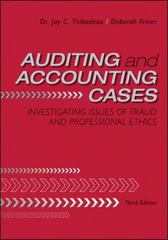FOF incorporated FOF Proprietary Funds, Ltd. (FOF Prop) as an umbrella for its specialized investment accounts that
Question:
FOF incorporated FOF Proprietary Funds, Ltd. (FOF Prop) as an umbrella for its specialized investment accounts that were managed by outside investment advisers. Each investment adviser had a duty to act in FOF’s best interests and to avoid conflicts of interest. Advisers were compensated based on the realized and unrealized (paper) appreciation of their investment portfolios.1 In a presentation at a meeting of the FOF board of directors in Acapulco, Mexico, on April 5, 1968, John King suggested that FOF establish a proprietary account with an initial allocation of \($10\) million that would be invested in a minimum of 40 properties. King described the role of King Resources as follows: “that of a vendor of properties to the proprietary account, with such properties to be sold on an arms-length basis at prices no less favorable to the proprietary account than the prices charged by King to its 200-odd industrial and other purchasers.”
The board approved the idea, and the National Resources Fund Account (NRFA) was established. Although no formal written agreement established the King Resources Corporation (KRC) as the investment adviser for the NRFA, FOF’s clear intent was to use KRC’s expertise to locate and purchase speculative natural resource investments. FOF had no means of valuing the assets proposed for investment by NRFA and did not possess the industry expertise to do so.
Independent Audit Relationships KRC, NRFA, and FOF were all audited by the same independent auditor, Arthur Andersen. Andersen’s Denver office performed the KRC audits, as well as performing substantial work on the NRFA. The partner in charge and the manager of the KRC audit held the same respective positions on the NRFA audit. Many aspects of the NRFA audit were completed by using the records of KRC, and sometimes Andersen staffers would even work on both the KRC and NRFA audits contemporaneously.
Finally, Arthur Andersen also audited various third parties to which KRC sold assets in order to ultimately determine the valuations of those assets.
FOF’s Natural Interest Purchases2 Beginning immediately after the board of directors’ meeting where NRFA was established, on April 5, 1968, it began to purchase oil, gas, and mineral interests from KRC. King reported to the FOF board of directors on August 2, 1968, that \($3\) million of the initial authorization of \($10\) million was committed. For the year-end 1968 audit of FOF by Andersen, the Denver office prepared a series of comparisons of prices charged by the King group to FOF, other King affiliates, and other knowledgeable industry purchasers. The “Summary of 1968 Sales” shows the following with respect....
Case Questions
1. Based on your understanding of audit evidence, did Arthur Andersen rely on competent and sufficient audit evidence in auditing the valuation assertion related to FOF’s natural resources assets? Why or why not?
2. Consider the series of comparisons prepared by the Denver office of Arthur Andersen of prices charged by the King group to FOF, King affiliates, and other knowledgeable industry purchasers. Can you think of any additional evidence that would have strengthened the “Summary of 1968 Sales”?
3. Explain the primary purpose of substantive analytical procedures. If you completed such procedures on FOF, do you think you could use KRC’s “Consolidated Sales to Industry,” which illustrated that KRC’s profits on sales to FOF were 68.2 percent, as compared to 36 percent on all other sales, to help execute substantive analytical procedures? How?
4. Do you believe Andersen had a duty of client confidentiality to KRC that would prohibit the firm from disclosing to FOF any relevant knowledge it may have had related to KRC’s costs? Why or why not?
Step by Step Answer:

Auditing And Accounting Cases Investigating Issues Of Fraud And Professional Ethics
ISBN: 9780078110818
3rd Edition
Authors: Jay Thibodeau, Deborah Freier





